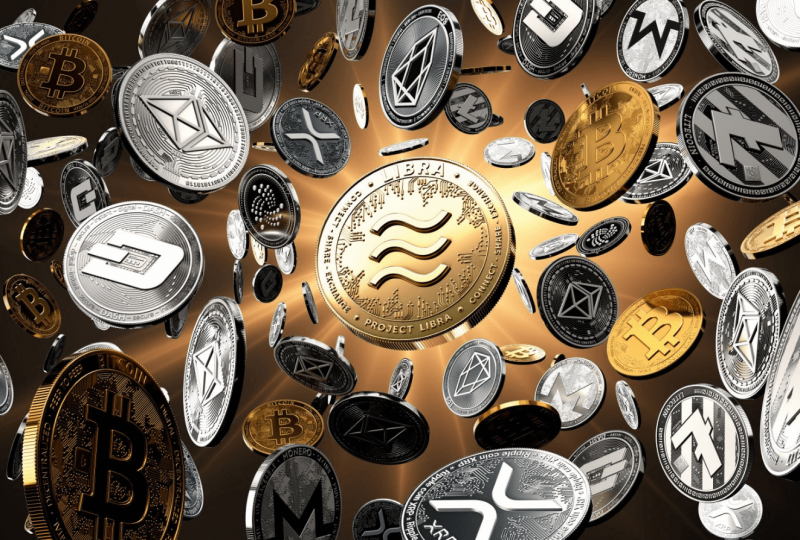10 Important Cryptocurrencies Other Than Bitcoin
Jan 10, 2022

Since Bitcoin pioneered the peer-to-peer model of cryptocurrency, it has become the de facto standard for all cryptocurrency ventures, motivating a rapidly growing army of followers and offshoots.
The Cryptocurrency: What Is It?
Before delving further into some of these Bitcoin alternative solutions, let's take a step back and define concepts like cryptocurrency and altcoin. A cryptocurrency, in general terms, is a virtual or digital currency in the form of tokens or "coins." While some cryptocurrencies have entered the actual world via bank cards or other schemes, the large bulk stays intangible.
The term "crypto" refers to the complex encryption that enables the creation and processing of digital currency and its operations across decentralized platforms. Along with this crucial "crypto" trait, these currencies all share a dedication to decentralization; cryptos are often created as code that includes methods for issuance (often via mining) and other regulations.
Cryptocurrencies are nearly always made to be independent of governmental influence. As the sector has risen in popularity, this fundamental characteristic has come under scrutiny. Altcoins, and in some instances shitcoins, are cryptocurrencies created after Bitcoin and have often attempted to promote themselves as updated or better variants of Bitcoin. While some of these cryptocurrencies may have some great features that Bitcoin has not, an altcoin has yet to meet the degree of security that Bitcoin's networks attain.
Apart from Bitcoin, we'll look at some of the most significant cryptos below. But first, a caveat: it is unrealistic for a list like this to be fully comprehensive. One explanation for this is that there are over 8,000 cryptocurrencies in use as of January 2022. While most of these cryptocurrencies have little to no following or trading volume, others are quite successful among committed supporters and traders.
Aside from that, the crypto sector is constantly evolving, and the next big digital token might be issued tomorrow. While Bitcoin is largely regarded as a leader in the crypto field, experts use a variety of methods to evaluate tokens other than BTC. Experts, for example, often place a high value on ranking currencies compared to one another in terms of market capitalization. We've taken this into account, but there are more causes why a crypto token may be on the list.
Altcoin Types
Cryptocurrencies
Cryptocurrencies are designed for transactions, moving values (similar to digital money) through a decentralized network of users. A lot of altcoins (those that are neither bitcoin or ethereum) are categorized in this manner and are frequently referred to as value tokens.
Tokens
There are other tokens based on blockchain that have a function other than monetary value. One instance is tokens issued as part of an initial coin offering (ICO) that represent shares in a blockchain or decentralized finance (DeFi) project. Security tokens are connected to the value of a business or project.
Some tokens provide a specific purpose or perform a specific task. Storj tokens, which let individuals transfer files over a decentralized network, or Namecoin, which offers decentralized Domain Name System (DNS) service for Internet addresses, are two instances. These are referred to as utility tokens.
Nowadays, although many crypto users recognize and respect these nuances, traders and lay investors may not see them since all types of tokens tend to trade in the same manner on cryptocurrency exchanges.
1. Ethereum (ETH)
Ethereum (ETH), the first Bitcoin rival on the list, is a decentralized software platform that allows smart contracts and decentralized apps (dApps) to be written and operated without delay, fraud, manipulation, or intervention from a 3rd party. The purpose of Ethereum is to establish a decentralized suite of financial goods that anybody in the globe, regardless of country, race, or creed, may easily utilize. This model made the implications for individuals in certain nations more appealing since those who lack state infrastructure and official identification may get bank accounts, loans, insurance, etc.
Ethereum apps are powered by ether, the software's crypto token. Ether (ETH) is like transport for traveling around the Ethereum platform. It is primarily preferred by devs trying to construct and operate apps inside Ethereum and traders wishing to acquire other cryptocurrencies using ether. Ether, which debuted in 2015, is now the second-largest virtual currency by market value behind Bitcoin, albeit it trails well behind the dominating cryptocurrency. Ether's market valuation is little more than half that of bitcoin, trading at roughly $3,200 per ETH in January 2022.
In 2014, Ethereum held an ether presale, which garnered a massive reaction, ushering in the era of the ICO. Ethereum claims that it can be used to "codify, decentralize, secure, and exchange just about anything." Following the 2016 assault on the decentralized autonomous organization (DAO), Ethereum was divided into two coins: Ethereum (ETH) and Ethereum Classic (ETC).
Ethereum's consensus method will be changed from proof of work (PoW) to proof of stake (PoS) in December 2020.
This change is designed to enable Ethereum's network to function with considerably less power and faster processing speeds and create a more deflationary economic climate. PoS enables network users to "stake" their ether to the network. This procedure aids in the security of the network and the payment process. Those who do so are rewarded with ether, which functions similarly to an interest account. This is a different system from Bitcoin's PoW, in which miners are rewarded with extra BTCs for transaction processing.
2. Litecoin (LTC)
Litecoin (LTC), which debuted in 2011, was one of the first cryptos to follow Bitcoin's path and dubbed the "silver to Bitcoin's gold." Charlie Lee, an MIT graduate and ex-Google developer designed it.
Litecoin is built on an open-source worldwide payment network that is not centralized and uses Scrypt as a PoW that can be decrypted by consumer-grade central processing units (CPUs). Litecoin is similar to Bitcoin in many aspects, except it has a quicker block creation rate and provides faster transaction confirmation time.
Aside from coders, there is an increasing list of shops that take Litecoin. Litecoin has a market valuation of $9 billion and a per-unit value of roughly $130 as of January 2022, making it the globe's 22nd-biggest digital currency.
3. Cardano (ADA)
Cardano (ADA) is an "Ouroboros proof-of-stake" cryptocurrency developed by engineers, scientists, and cryptography professionals using a research-based method. Charles Hoskinson, one of Ethereum's five founders, co-founded the initiative. He quit Ethereum after some issues with the way it was headed and eventually worked to build Cardano.
Cardano's blockchain was established via considerable testing and peer-reviewed studies by the Cardano group. The project's members have published over 120 papers on blockchain architecture, covering a wide variety of issues. Cardano is built on this study.
Cardano appears to stand out among its PoS counterparts and other significant cryptocurrencies as a result of this rigorous approach. Cardano has also been branded the "Ethereum killer," as their blockchain has more capabilities, according to its creators. Cardano is still in its early phases. While it has already surpassed Ethereum in terms of PoS consensus, it still has a long way to go in terms of DeFi apps.
Cardano aspires to be the globe's financial operating platform by developing DeFi services comparable to Ethereum and offering solutions for chain interoperability, voter fraud, and legal contract tracking, among other things. Cardano is the seventh-biggest market cap at $37 billion as of January 2022, and one ADA is worth roughly $1.15.
4. Polkadot (DOT)
Polkadot (DOT) is a one-of-a-kind PoS currency that aims to provide compatibility with other blockchains. Its protocol connects permissioned and permissionless blockchains and oracles, allowing platforms to collaborate under one roof. Polkadot's essential element is its relay chain, which enables network compatibility. Parachains, or alternative blockchains with their native tokens, are also supported for certain use scenarios.
Polkadot contrasts with Ethereum in that instead of only establishing dApps on Polkadot, devs may design their blockchain while still benefiting from the safety that Polkadot's chain currently possesses. Programmers may establish new blockchains using Ethereum, but they must design their security mechanisms, putting new and smaller projects vulnerable to attack. The bigger a blockchain, the more secure it is. This is termed shared security in Polkadot.
Polkadot was built by Gavin Wood, another Ethereum project's core founder with differing views on the development's direction. Polkadot has over $26 billion as of January 2022, and one DOT is worth $24.50.
5. Bitcoin Cash (BCH)
Bitcoin Cash (BCH) is significant in altcoin history since it was one of the first and most effective hard forks of the basic Bitcoin. A split occurs in the bitcoin realm due to disagreements and conflicts between programmers and miners. Because virtual currencies are decentralized, radical changes to the code underpinning the token or coin at hand must be established by broad agreement; the method for this procedure differs depending on the currency.
When various groups cannot agree, the cryptocurrency may occasionally split, with the previous chain staying faithful to its existing code and the new chain starting as a new variant of the preceding coin, replete with code modifications.
As a consequence of one of these splits, BCH was born in August 2017. The discussion that resulted in the formation of BCH was over scalability; the Bitcoin network has a restriction on the capacity of blocks: one megabyte (MB). BCH raises the block size from one MB to eight MBs, with the theory that bigger blocks may carry more operations and boost process efficiency. Other modifications include eliminating the Segregated Witness protocol, which has an effect on block space.
BCH has a market valuation of roughly $7 billion and a token value of $372 as of December 2021.
6. Stellar (XLM)
Stellar (XLM) is an open blockchain platform that connects financial institutions to offer corporate options for massive operations. Massive transfers between banks and companies, which used to take days, involve a number of middlemen, and cost a lot of money, may now be completed instantly with no intermediaries and at little to no cost to the parties involved.
Stellar has presented itself as a blockchain for institutional transactions, yet it is still a fully accessible blockchain that anybody may use. The technology supports cross-border operations in many currencies. Lumens are Stellar's native currency (XLM). To operate on the platform, users must have Lumens in their possession.
Jed McCaleb, a founder of Ripple Labs and the creator of the Ripple protocol, launched Stellar. He ultimately quit his position at Ripple to co-found the Stellar Development Foundation. Stellar Lumens have a market cap of $6.4 billion and are worth $0.26 per unit as of January 2022.
7. Dogecoin (DOGE)
Litecoin (DOGE), considered by some to be the first "meme coin," made a sensation in 2021 when its price surged. The coin, which has a picture of a Shiba Inu as its mascot, is accepted as payment by some big corporations, including the Dallas Mavericks, Kronos, and most importantly, SpaceX, an American rocket company founded by Elon Musk.
In 2013, two software programmers, Billy Markus and Jackson Palmer invented Dogecoin. Markus and Palmer designed the coin as a joke, reflecting on the crypto market's rampant speculation.
During the week that Musk was set to appear on "Saturday Night Live," the value of DOGE reached a record of $0.68. Dogecoin has a market valuation of $20 billion as of December 2021, and one DOGE is worth roughly $0.15, making it the 12th-biggest digital currency.
8. Binance Coin (BNB)
Binance Coin (BNB) is a utility cryptocurrency that serves as a payment option for transaction fees on the Binance Exchange. By market valuation, it is the third-biggest digital currency. Those that utilize the token as payment for the exchanges may trade at a reduced rate.
Binance Coin's blockchain also serves as Binance's decentralized exchange foundation. Changpeng Zhao launched the Binance Exchange, which is now one of the biggest and most popular platforms in terms of the trading volume.
Binance Coin began as an ERC-20 token that ran on the Ethereum network. It later had its mainnet. The platform employs a proof-of-stake (PoS) consensus method. Binance Coin has a market valuation of $73.3 billion as of January 2022, with one BNB worth $435.
9. Tether (USDT)
Tether (USDT) was one of the earliest and most prominent of a class of currencies known as stablecoins, which try to limit volatility by tying their market price to a currency or other external point of reference. Because most cryptocurrencies, even big ones such as Bitcoin, have undergone regular bouts of extreme volatility, Tether and other stablecoins aim to balance price changes to gain users who may otherwise be careful. Tether's value is entirely proportional to the value of the US dollar. The mechanism enables users to make exchanges from other digital currencies back to US dollars more quickly than converting to regular money.
Tether, founded in 2014, presents itself as "a blockchain-enabled platform...to make it simpler to utilize fiat money digitally."
This coin, in effect, lets users utilize blockchain infrastructure and linked technologies to deal in conventional currencies while limiting the volatility and complexity that are sometimes associated with cryptocurrencies.
Tether is the fourth-biggest cryptocurrency by market capitalization as of December 2021, with a market valuation of $77.9 billion and a single token worth $1.
10. Monero (XMR)
Monero (XMR) is a safe, anonymous, and undetectable cryptocurrency. This open-source digital currency debuted in April 2014 and quickly gained popularity in the cryptography sector. It exists entirely due to donations and community interest.
Monero was created with a heavy emphasis on decentralization and scalability in mind, and it provides perfect confidentiality via the use of a specific technology known as "ring signatures." With this approach, a collection of cryptographic signatures emerges, each of them has at least one genuine member, but the genuine one cannot be identified since they all look authentic.
Monero has gained an unpleasant image as a result of extraordinary security methods as it has been tied to illegal enterprises all over the globe. While this is an excellent option for anonymized illegal operations, the anonymity inherent in Monero is also beneficial to protestors in despotic regimes all over the globe.




